air condition KIA Sephia 2007 2.G Owner's Manual
[x] Cancel search | Manufacturer: KIA, Model Year: 2007, Model line: Sephia, Model: KIA Sephia 2007 2.GPages: 300, PDF Size: 2.91 MB
Page 14 of 300

Knowing your vehicle43
1
2
3
4
5
6
7
8
9
✽ ✽NOTICEThe transmitter will not work if any
of following occur:
- The ignition key is in ignition
switch.
- You exceed the operating distance limit (about 30 m [100 feet]).
- The battery in the transmitter is weak.
- Other vehicles or objects may be blocking the signal.
- The weather is extremely cold.
- The transmitter is close to a radio transmitter such as a radio station
or an airport which can interfere
with normal operation of the
transmitter.
When the transmitter does not work
correctly, open and close the door
with the ignition key. If you have a
problem with the transmitter, con-
tact an authorized Kia Dealer.
Operational distance may vary
depending upon the area the trans-
mitter is used in. For example, if the
vehicle is parked near police sta-
tions, government and public offices,
broadcasting stations, military instal-
lations, airports, or transmitting tow-
ers, etc. This device complies with
Industry Canada Standard RSS-
210.
Operation is subject to the fol-
lowing two conditions:
1. This device may not cause harm- ful interference, and
2. This device must accept any inter- ference received, including inter-
ference that may cause undesired
operation.
WARNING
Changes or modifications not
expressly approved by the party
responsible for compliance
could void the user's authority
to operate the equipment.
CAUTION
Keep the transmitter away fromwater or any liquid. If the key-less entry system is inoperativedue to exposure to water or liq-uids, it will not be covered byyour manufacturer vehicle war-ranty.
Page 53 of 300
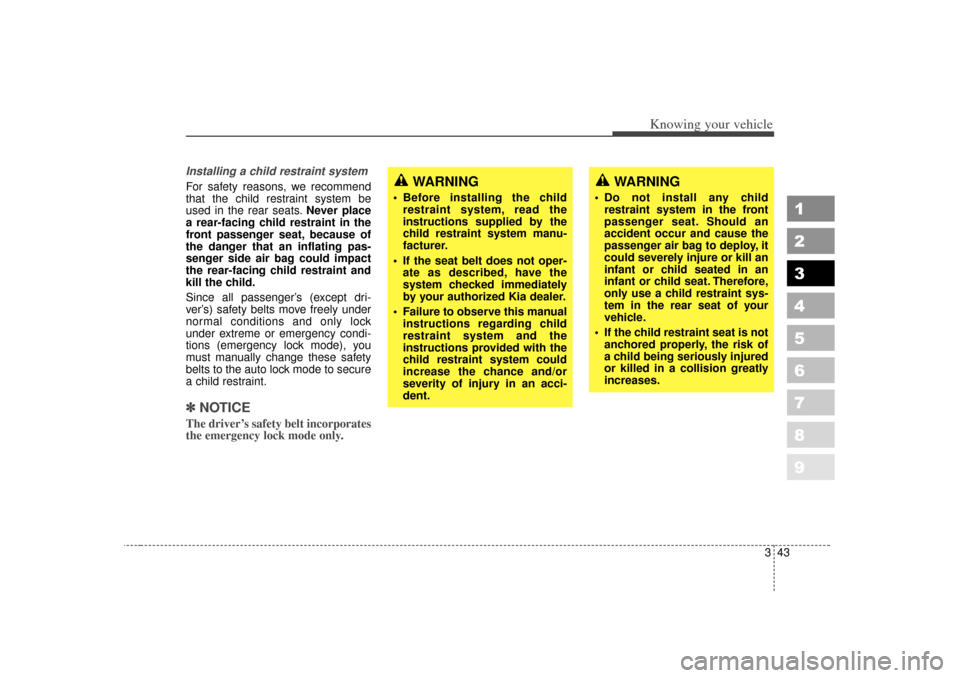
343
1
2
3
4
5
6
7
8
9
Knowing your vehicle
Installing a child restraint system For safety reasons, we recommend
that the child restraint system be
used in the rear seats.Never place
a rear-facing child restraint in the
front passenger seat, because of
the danger that an inflating pas-
senger side air bag could impact
the rear-facing child restraint and
kill the child.
Since all passenger’s (except dri-
ver’s) safety belts move freely under
normal conditions and only lock
under extreme or emergency condi-
tions (emergency lock mode), you
must manually change these safety
belts to the auto lock mode to secure
a child restraint.✽ ✽ NOTICEThe driver’s safety belt incorporates
the emergency lock mode only.
WARNING
Do not install any child
restraint system in the front
passenger seat. Should an
accident occur and cause the
passenger air bag to deploy, it
could severely injure or kill an
infant or child seated in an
infant or child seat. Therefore,
only use a child restraint sys-
tem in the rear seat of your
vehicle.
If the child restraint seat is not anchored properly, the risk of
a child being seriously injured
or killed in a collision greatly
increases.
WARNING
Before installing the childrestraint system, read the
instructions supplied by the
child restraint system manu-
facturer.
If the seat belt does not oper- ate as described, have the
system checked immediately
by your authorized Kia dealer.
Failure to observe this manual instructions regarding child
restraint system and the
instructions provided with the
child restraint system could
increase the chance and/or
severity of injury in an acci-
dent.
Page 62 of 300
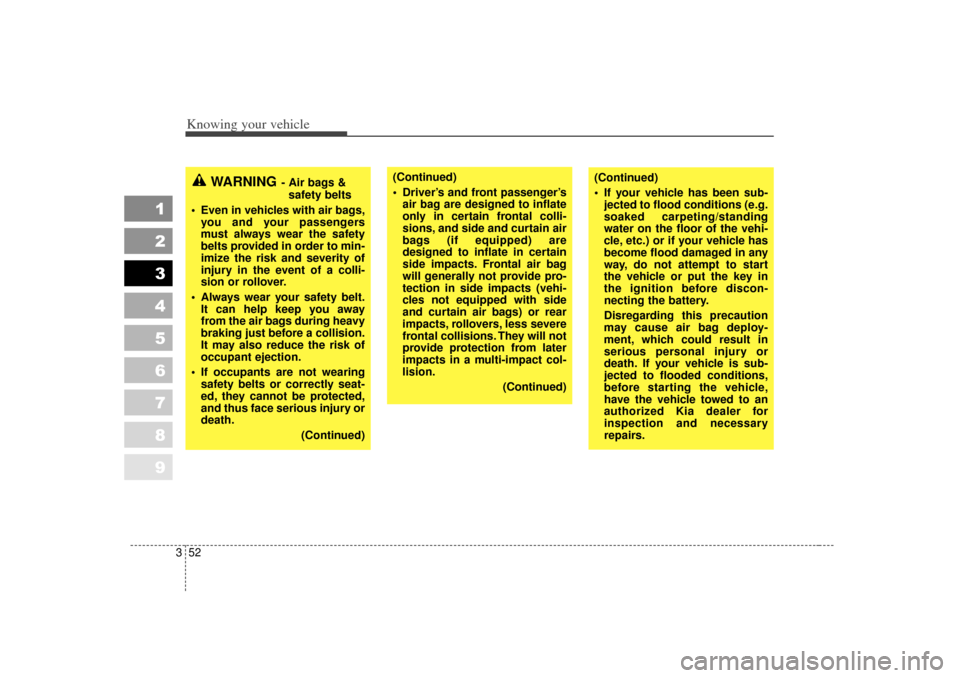
Knowing your vehicle52
3
1
2
3
4
5
6
7
8
9
WARNING
- Air bags &
safety belts
Even in vehicles with air bags, you and your passengers
must always wear the safety
belts provided in order to min-
imize the risk and severity of
injury in the event of a colli-
sion or rollover.
Always wear your safety belt. It can help keep you away
from the air bags during heavy
braking just before a collision.
It may also reduce the risk of
occupant ejection.
If occupants are not wearing safety belts or correctly seat-
ed, they cannot be protected,
and thus face serious injury or
death.
(Continued)
(Continued)
Driver’s and front passenger’sair bag are designed to inflate
only in certain frontal colli-
sions, and side and curtain air
bags (if equipped) are
designed to inflate in certain
side impacts. Frontal air bag
will generally not provide pro-
tection in side impacts (vehi-
cles not equipped with side
and curtain air bags) or rear
impacts, rollovers, less severe
frontal collisions. They will not
provide protection from later
impacts in a multi-impact col-
lision.
(Continued)
(Continued)
If your vehicle has been sub-jected to flood conditions (e.g.
soaked carpeting/standing
water on the floor of the vehi-
cle, etc.) or if your vehicle has
become flood damaged in any
way, do not attempt to start
the vehicle or put the key in
the ignition before discon-
necting the battery.
Disregarding this precaution
may cause air bag deploy-
ment, which could result in
serious personal injury or
death. If your vehicle is sub-
jected to flooded conditions,
before starting the vehicle,
have the vehicle towed to an
authorized Kia dealer for
inspection and necessary
repairs.
Page 63 of 300
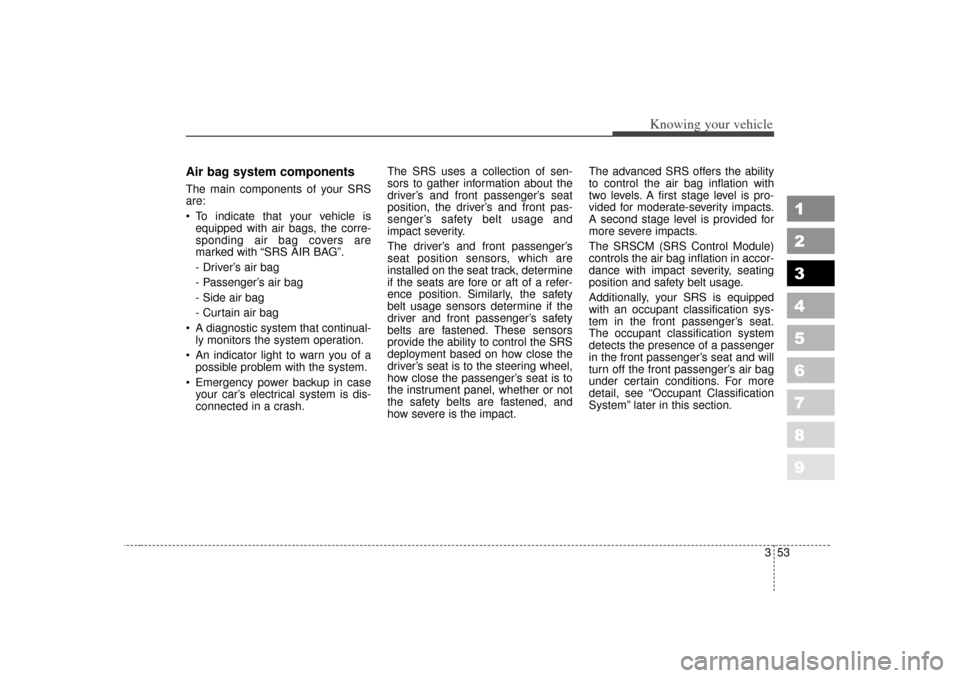
353
1
2
3
4
5
6
7
8
9
Knowing your vehicle
Air bag system components The main components of your SRS
are:
To indicate that your vehicle is
equipped with air bags, the corre-
sponding air bag covers are
marked with “SRS AIR BAG”.
- Driver’ s air bag
- Passenger’ s air bag
- Side air bag
- Curtain air bag
A diagnostic system that continual-
ly monitors the system operation.
An indicator light to warn you of a
possible problem with the system.
Emergency power backup in case
your car’ s electrical system is dis-
connected in a crash. The SRS uses a collection of sen-
sors to gather information about the
driver’
s and front passenger’ s seat
position, the driver’ s and front pas-
senger’ s safety belt usage and
impact severity.
The driver’ s and front passenger’ s
seat position sensors, which are
installed on the seat track, determine
if the seats are fore or aft of a refer-
ence position. Similarly, the safety
belt usage sensors determine if the
driver and front passenger’ s safety
belts are fastened. These sensors
provide the ability to control the SRS
deployment based on how close the
driver’ s seat is to the steering wheel,
how close the passenger’ s seat is to
the instrument panel, whether or not
the safety belts are fastened, and
how severe is the impact. The advanced SRS offers the ability
to control the air bag inflation with
two levels. A first stage level is pro-
vided for moderate-severity impacts.
A second stage level is provided for
more severe impacts.
The SRSCM (SRS Control Module)
controls the air bag inflation in accor-
dance with impact severity, seating
position and safety belt usage.
Additionally, your SRS is equipped
with an occupant classification sys-
tem in the front passenger’
s seat.
The occupant classification system
detects the presence of a passenger
in the front passenger’ s seat and will
turn off the front passenger ’s air bag
under certain conditions. For more
detail, see “Occupant Classification
System” later in this section.
Page 66 of 300

Knowing your vehicle56
3
1
2
3
4
5
6
7
8
9
Occupant classification systemThe occupant classification system
detects the presence of a passenger
in the front passenger's seat and will
turn off the front passenger's air bag
under certain conditions.
The occupant classification system is
designed to detect the presence of a
properly-seated occupant and deter-
mine if the front passenger's air bag
should be enabled (may inflate) or
not.
Only the front passenger air bag is
controlled by the Occupant
Classification System.
Main components of occupant
classification system A detection device located within
the front passenger seat cushion.
Electronic system to determine
whether passenger air bag system
should be activated or deactivated.
A indicator light located on the
instrument panel which illuminates
the words "PASSENGER AIR BAG
OFF" indicating the frontal passen-
ger air bag system is deactivated.
The instrument panel air bag warn-
ing light is interconnected with the
occupant classification system. If there is no passenger in the front
passenger seat or if the passenger in
the front passenger seat is very light,
(such as a child), the front
PASSEN-
GER AIR BAG OFF indicator may
illuminate.
When this indicator is ON, the front
passenger front air bag will not
deploy.
1LDN2166
OLD036150N
The location of OCS Indicator
Page 68 of 300
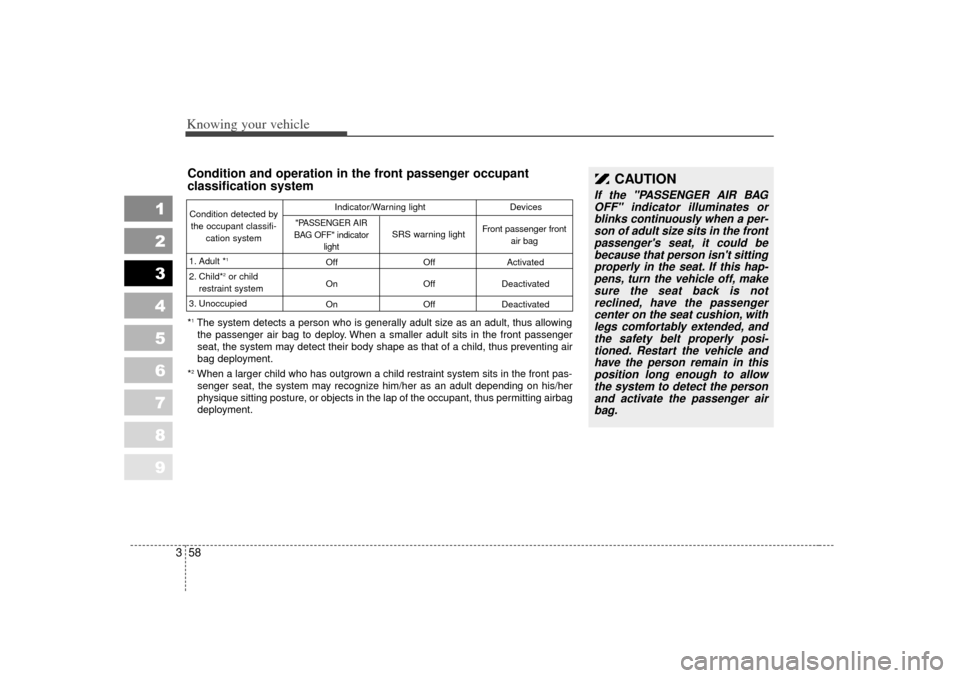
Knowing your vehicle58
3
1
2
3
4
5
6
7
8
9
Condition and operation in the front passenger occupant
classification systemCondition detected by
the occupant classifi- cation system
1. Adult *
1
2. Child*
2or child
restraint system
3. Unoccupied Off
On
On Off
Off
OffActivated
Deactivated
Deactivated
"PASSENGER AIR
BAG OFF" indicator light
SRS warning light Front passenger front
air bag
Indicator/Warning light
Devices
*1The system detects a person who is generally adult size as an adult, thus allowing
the passenger air bag to deploy. When a smaller adult sits in the front passenger
seat, the system may detect their body shape as that of a child, thus preventing air
bag deployment.
*2When a larger child who has outgrown a child restraint system sits in the front pas- senger seat, the system may recognize him/her as an adult depending on his/her
physique sitting posture, or objects in the lap of the occupant, thus permitting airbag
deployment.
CAUTION
If the "PASSENGER AIR BAG OFF" indicator illuminates orblinks continuously when a per-son of adult size sits in the frontpassenger's seat, it could bebecause that person isn't sittingproperly in the seat. If this hap-pens, turn the vehicle off, makesure the seat back is notreclined, have the passengercenter on the seat cushion, withlegs comfortably extended, andthe safety belt properly posi-tioned. Restart the vehicle andhave the person remain in thisposition long enough to allowthe system to detect the personand activate the passenger airbag.
Page 71 of 300
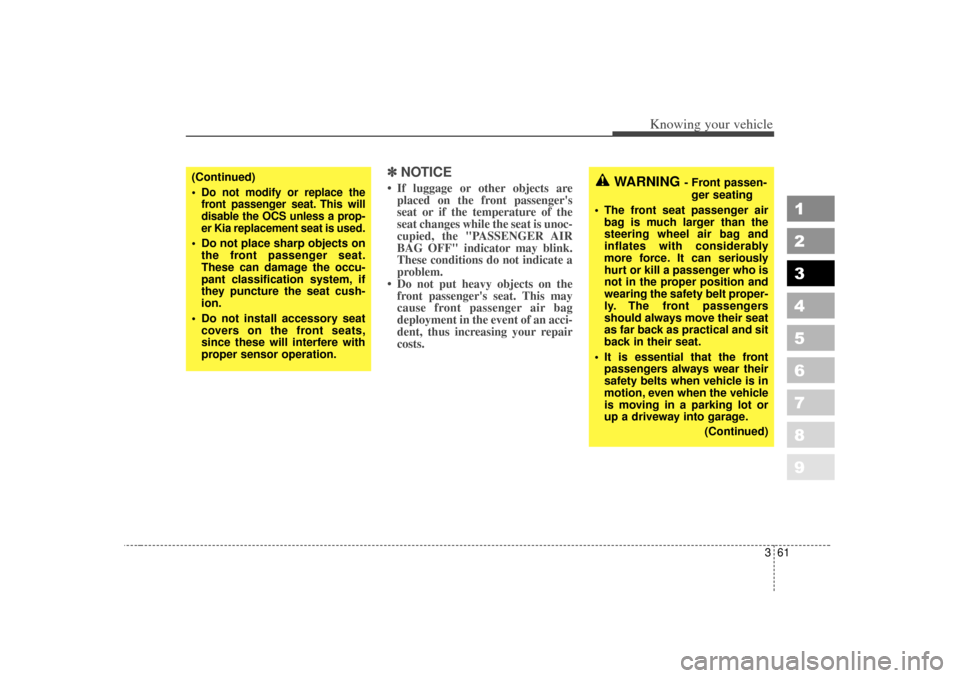
361
1
2
3
4
5
6
7
8
9
Knowing your vehicle
✽ ✽NOTICE• If luggage or other objects are
placed on the front passenger's
seat or if the temperature of the
seat changes while the seat is unoc-
cupied, the "PASSENGER AIR
BAG OFF" indicator may blink.
These conditions do not indicate a
problem.
• Do not put heavy objects on the front passenger's seat. This may
cause front passenger air bag
deployment in the event of an acci-
dent, thus increasing your repair
costs.
WARNING
- Front passen-
ger seating
The front seat passenger air bag is much larger than the
steering wheel air bag and
inflates with considerably
more force. It can seriously
hurt or kill a passenger who is
not in the proper position and
wearing the safety belt proper-
ly. The front passengers
should always move their seat
as far back as practical and sit
back in their seat.
It is essential that the front passengers always wear their
safety belts when vehicle is in
motion, even when the vehicle
is moving in a parking lot or
up a driveway into garage.
(Continued)
(Continued)
Do not modify or replace the
front passenger seat. This will
disable the OCS unless a prop-
er Kia replacement seat is used. Do not place sharp objects onthe front passenger seat.
These can damage the occu-
pant classification system, if
they puncture the seat cush-
ion.
Do not install accessory seat covers on the front seats,
since these will interfere with
proper sensor operation.
Page 72 of 300

Knowing your vehicle62
3
1
2
3
4
5
6
7
8
9
Side air bag (if equipped)Side air bags are stored in the left
side of the driver’ s seat and right side
of the front passenger’ s seat.
If air bag inflation conditions are met
(side collision), they will inflate.
1LDA2056
1LDN2050/1LDN2051
(Continued)
If the driver brakes the vehicle heavily prior to an impact,
unbelted occupants will be
thrown forward. If the front
passenger is not wearing the
safety belts, they will be
directly in front of the air bag
when deployment occurs. In
that situation, serious injury
or death is possible.
Never allow front passenger to put their hands, feet or face
on or close to the instrument
panel. In the event of air bag
deployment, such a misposi-
tioned occupant would be
likely to suffer severe injury or
death.
Never allow children, pregnant women or weak persons to sit
in the front passenger seat.
They may be seriously injured
by the air bag inflation when
air bag deploys.
(Continued)
(Continued)
Never allow children, pregnantwomen or weak persons to sit
in the front passenger seat.
Do not put child restraint sys-
tem on the front passenger's
seat either. They may be seri-
ously injured by the airbag
inflation when airbag deploys.
Do not put objects or stickers on the instrument panel. Do
not apply any accessory to the
front windshield. Do not install
aftermarket mirrors or acces-
sories on the factory-installed
rearview mirror. Any of these
could interfere with the
deployment of the air bag or
could hit your body at high
speed and cause severe bodi-
ly injury and even death.
Page 76 of 300
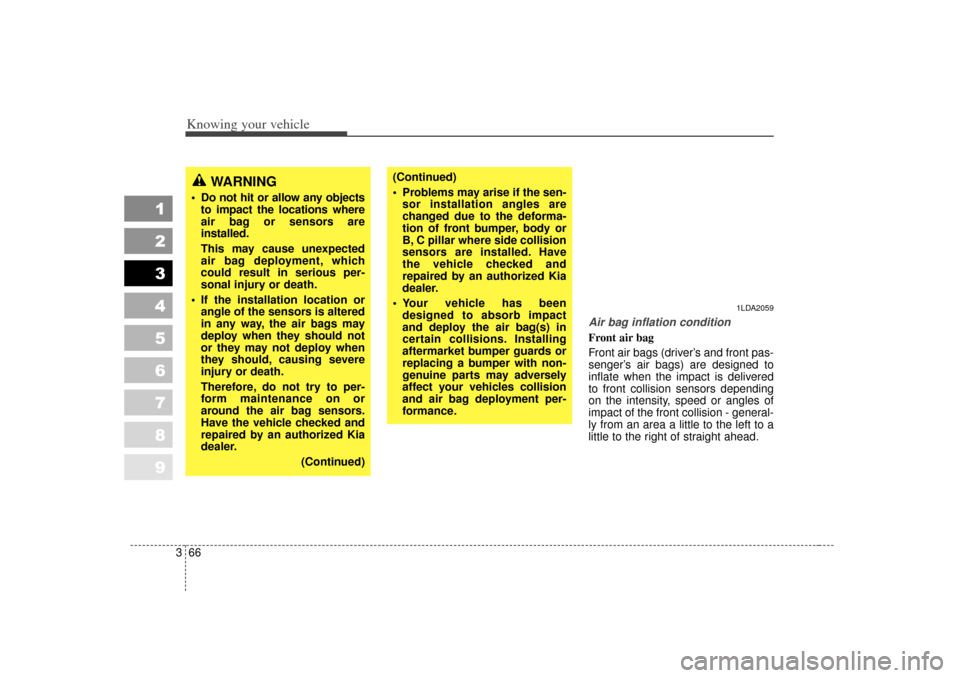
Knowing your vehicle66
3
1
2
3
4
5
6
7
8
9
Air bag inflation conditionFront air bag
Front air bags (driver ’s and front pas-
senger’ s air bags) are designed to
inflate when the impact is delivered
to front collision sensors depending
on the intensity, speed or angles of
impact of the front collision - general-
ly from an area a little to the left to a
little to the right of straight ahead.
WARNING
Do not hit or allow any objects to impact the locations where
air bag or sensors are
installed.
This may cause unexpected
air bag deployment, which
could result in serious per-
sonal injury or death.
If the installation location or angle of the sensors is altered
in any way, the air bags may
deploy when they should not
or they may not deploy when
they should, causing severe
injury or death.
Therefore, do not try to per-
form maintenance on or
around the air bag sensors.
Have the vehicle checked and
repaired by an authorized Kia
dealer.
(Continued)
(Continued)
Problems may arise if the sen-sor installation angles are
changed due to the deforma-
tion of front bumper, body or
B, C pillar where side collision
sensors are installed. Have
the vehicle checked and
repaired by an authorized Kia
dealer.
Your vehicle has been designed to absorb impact
and deploy the air bag(s) in
certain collisions. Installing
aftermarket bumper guards or
replacing a bumper with non-
genuine parts may adversely
affect your vehicles collision
and air bag deployment per-
formance.
1LDA2059
Page 78 of 300
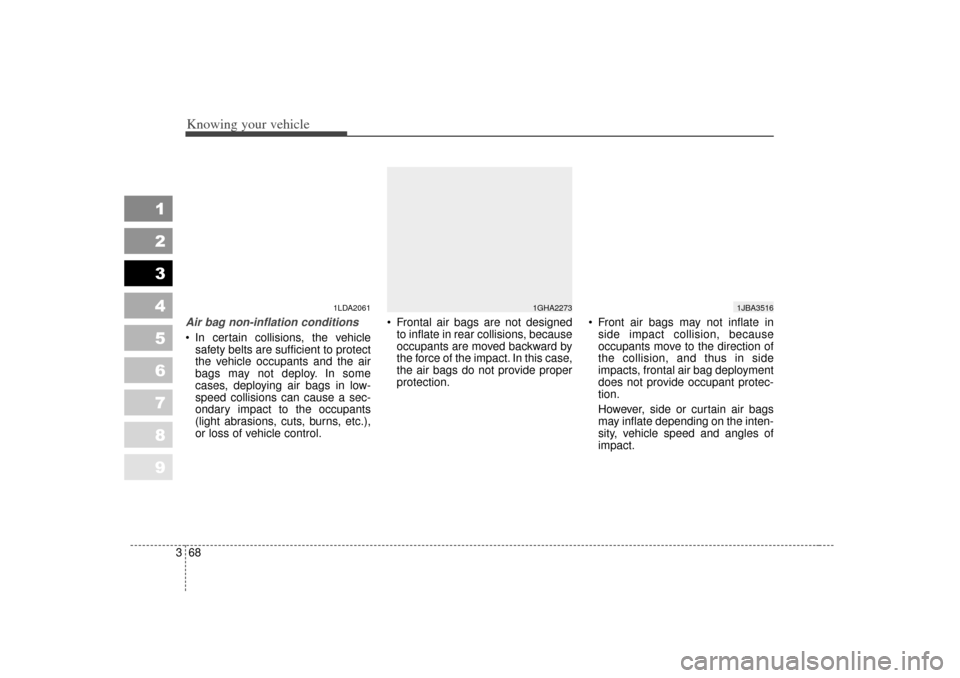
Knowing your vehicle68
3
1
2
3
4
5
6
7
8
9
Air bag non-inflation conditions In certain collisions, the vehicle
safety belts are sufficient to protect
the vehicle occupants and the air
bags may not deploy. In some
cases, deploying air bags in low-
speed collisions can cause a sec-
ondary impact to the occupants
(light abrasions, cuts, burns, etc.),
or loss of vehicle control.
Frontal air bags are not designed
to inflate in rear collisions, because
occupants are moved backward by
the force of the impact. In this case,
the air bags do not provide proper
protection.
Front air bags may not inflate in
side impact collision, because
occupants move to the direction of
the collision, and thus in side
impacts, frontal air bag deployment
does not provide occupant protec-
tion.
However, side or curtain air bags
may inflate depending on the inten-
sity, vehicle speed and angles of
impact.
1GHA2273
1LDA2061
1JBA3516